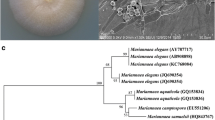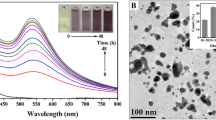Abstract
Objective
To investigate green synthesis of gold nanoparticles (AuNPs) by Trichosporon montevideense, and to study their reduction of nitroaromatics.
Results
AuNPs had a characteristic absorption maximum at 535 nm. Scanning electron microscopy images revealed that the biosynthesized nanoparticles were attached on the cell surface. X-ray diffraction analysis indicated that the particles formed as face-centered cubic (111)-oriented crystals. The average size of AuNPs decreased from 53 to 12 nm with increasing biomass concentration. The catalytic reduction of 2-nitrophenol, 3-nitrophenol, 4-nitrophenol, o-nitrophenylamine and m-nitrophenylamine (0.1 mM) by NaBH4 had reaction rate constants of 0.32, 0.44, 0.09, 0.24 and 0.39 min−1 with addition of 1.45 × 10−2 mM AuNPs.
Conclusions
An eco-friendly approach for synthesis of AuNPs by T. montevideense is reported for the first time. The biogenic AuNPs could serve as efficient catalysts for hydrogenation of various nitroaromatics.



Similar content being viewed by others
References
Chang YC, Chen DH (2009) Catalytic reduction of 4-nitrophenol by magnetically recoverable Au nanocatalyst. J Hazard Mater 165:664–669
Chiou JR, Lai BH, Hsu KC, Chen DH (2013) One-pot green synthesis of silver/iron oxide composite nanoparticles for 4-nitrophenol reduction. J Hazard Mater 248:394–400
Das SK, Khan MMR, Guha AK, Naskar N (2013) Bio-inspired fabrication of silver nanoparticles on nanostructured silica: characterization and application as a highly efficient hydrogenation catalyst. Green Chem 15:2548–2557
Gangula A, Podila R, Karanam L, Karanam L, Janardhana C, Rao AM (2011) Catalytic reduction of 4-nitrophenol using biogenic gold and silver nanoparticles derived from Breynia rhamnoides. Langmuir 27:15268–15274
Liu H, Yu QJ, Wang G, Ye F, Cong YY (2011) Biodegradation of phenol at high concentration by a novel yeast Trichosporon montevideense PHE1. Proc Biochem 46:1678–1681
Mata R, Bhaskaran A, Sadras SR (2015) Green-synthesized gold nanoparticles from Plumeria alba flower extract to augment catalytic degradation of organic dyes and inhibit bacterial growth. Particuology 24:78–86
Mishra A, Kumari M, Pandey S, Chaudhry V, Gupta KC, Nautiyal CS (2014) Biocatalytic and antimicrobial activities of gold nanoparticles synthesized by Trichoderma sp. Bioresour Technol 166:235–242
Monteiro AS, Coutinho JOPA, Júnior AC, Rose CA, Siqueira EP, Santos VL (2009) Characterization of new biosurfactant produced by Trichosporon montevideense CLOA 72 isolated from dairy industry effluents. J Basic Microbiol 49:553–563
Narayanan KB, Sakthivel N (2008) Coriander leaf mediated biosynthesis of gold nanoparticles. Mater Lett 62:4588–4590
Narayanan KB, Sakthivel N (2011) Synthesis and characterization of nano-gold composite using Cylindrocladium floridanum and its heterogeneous catalysis in the degradation of 4-nitrophenol. J Hazard Mater 189:519–525
Park TJ, Lee KG, Lee SY (2016) Advances in microbial biosynthesis of metal nanoparticles. Appl Microbiol Biotechnol 100:521–534
Schlüter R, Lippmann R, Hammer E, Salazar MG, Schauer F (2013) Novel insights into the fungal oxidation of monoaromatic and biarylic environmental pollutants by characterization of two new ring cleavage enzymes. Appl Microbiol Biotechnol 97:5043–5053
Shedbalkar U, Singh R, Wadhwani S, Gaidhani S, Chopade BA (2014) Microbial synthesis of gold nanoparticles: current status and future prospects. Adv Colloid Interface Sci 209:40–48
Zhang XL, Yan S, Tyagi RD, Surampalli RY (2011) Synthesis of nanoparticles by microorganisms and their application in enhancing microbiological reaction rates. Chemosphere 82:489–494
Acknowledgments
This work was supported by the National Natural Science Foundation of China (No. 51508068), the Program for New Century Excellent Talents in University (No. NCET-13-0077), the Fundamental Research Funds for the Central Universities (No. DUT14YQ107), and the Open Project of State Key Laboratory of Urban Water Resource and Environment, Harbin Institute of Technology (No. ESK201529).
Supporting Information
Supplementary materials and methods—Materials used in this study and method of identification of strain WIN.
Supplementary results and discussion—Isolation and identification of strain WIN.
Supplementary Fig. 1—The SEM image (a) and agar plate photo (b) of strain WIN. c Phylogenetic tree of Trichosporon montevideense WIN and related species.
Author information
Authors and Affiliations
Corresponding author
Electronic supplementary material
Below is the link to the electronic supplementary material.
Rights and permissions
About this article
Cite this article
Shen, W., Qu, Y., Pei, X. et al. Green synthesis of gold nanoparticles by a newly isolated strain Trichosporon montevideense for catalytic hydrogenation of nitroaromatics. Biotechnol Lett 38, 1503–1508 (2016). https://doi.org/10.1007/s10529-016-2120-5
Received:
Accepted:
Published:
Issue Date:
DOI: https://doi.org/10.1007/s10529-016-2120-5




